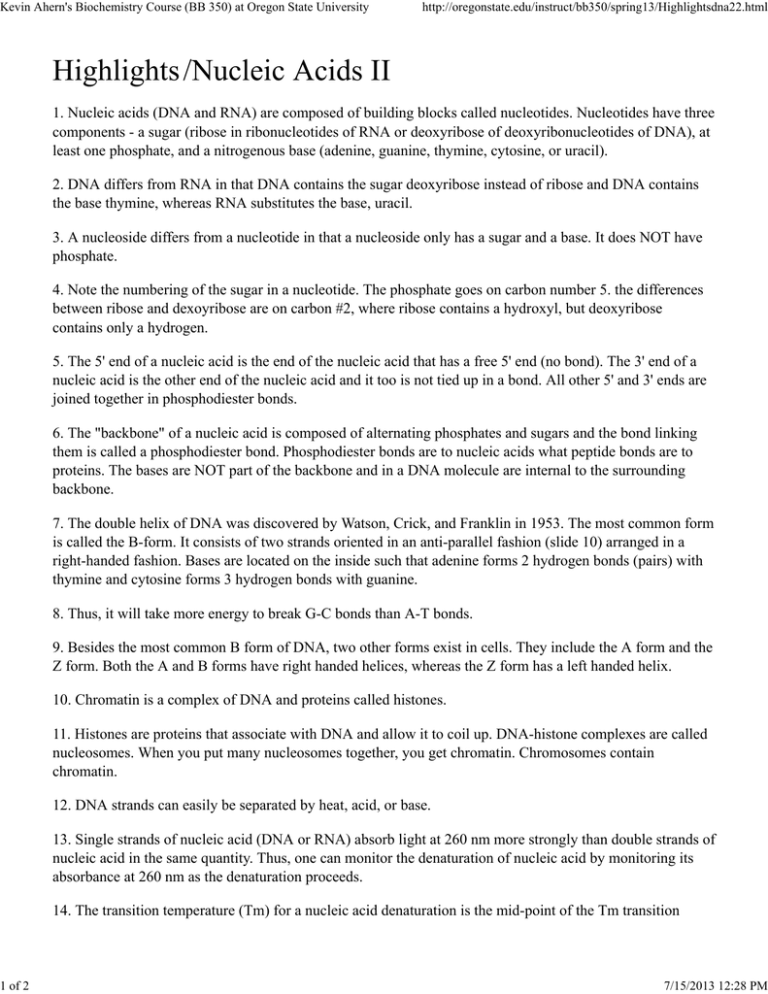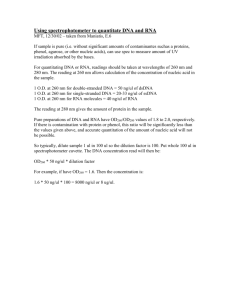Kevin Ahern's Biochemistry Course (BB 350) at Oregon State University
advertisement

Kevin Ahern's Biochemistry Course (BB 350) at Oregon State University 1 of 2 http://oregonstate.edu/instruct/bb350/spring13/Highlightsdna22.html Highlights /Nucleic Acids II 1. Nucleic acids (DNA and RNA) are composed of building blocks called nucleotides. Nucleotides have three components - a sugar (ribose in ribonucleotides of RNA or deoxyribose of deoxyribonucleotides of DNA), at least one phosphate, and a nitrogenous base (adenine, guanine, thymine, cytosine, or uracil). 2. DNA differs from RNA in that DNA contains the sugar deoxyribose instead of ribose and DNA contains the base thymine, whereas RNA substitutes the base, uracil. 3. A nucleoside differs from a nucleotide in that a nucleoside only has a sugar and a base. It does NOT have phosphate. 4. Note the numbering of the sugar in a nucleotide. The phosphate goes on carbon number 5. the differences between ribose and dexoyribose are on carbon #2, where ribose contains a hydroxyl, but deoxyribose contains only a hydrogen. 5. The 5' end of a nucleic acid is the end of the nucleic acid that has a free 5' end (no bond). The 3' end of a nucleic acid is the other end of the nucleic acid and it too is not tied up in a bond. All other 5' and 3' ends are joined together in phosphodiester bonds. 6. The "backbone" of a nucleic acid is composed of alternating phosphates and sugars and the bond linking them is called a phosphodiester bond. Phosphodiester bonds are to nucleic acids what peptide bonds are to proteins. The bases are NOT part of the backbone and in a DNA molecule are internal to the surrounding backbone. 7. The double helix of DNA was discovered by Watson, Crick, and Franklin in 1953. The most common form is called the B-form. It consists of two strands oriented in an anti-parallel fashion (slide 10) arranged in a right-handed fashion. Bases are located on the inside such that adenine forms 2 hydrogen bonds (pairs) with thymine and cytosine forms 3 hydrogen bonds with guanine. 8. Thus, it will take more energy to break G-C bonds than A-T bonds. 9. Besides the most common B form of DNA, two other forms exist in cells. They include the A form and the Z form. Both the A and B forms have right handed helices, whereas the Z form has a left handed helix. 10. Chromatin is a complex of DNA and proteins called histones. 11. Histones are proteins that associate with DNA and allow it to coil up. DNA-histone complexes are called nucleosomes. When you put many nucleosomes together, you get chromatin. Chromosomes contain chromatin. 12. DNA strands can easily be separated by heat, acid, or base. 13. Single strands of nucleic acid (DNA or RNA) absorb light at 260 nm more strongly than double strands of nucleic acid in the same quantity. Thus, one can monitor the denaturation of nucleic acid by monitoring its absorbance at 260 nm as the denaturation proceeds. 14. The transition temperature (Tm) for a nucleic acid denaturation is the mid-point of the Tm transition 7/15/2013 12:28 PM Kevin Ahern's Biochemistry Course (BB 350) at Oregon State University 2 of 2 http://oregonstate.edu/instruct/bb350/spring13/Highlightsdna22.html 15. Renaturation is the opposite of denaturation. Renaturation puts single strands together. Both denaturation and renaturation are important for anyone running the polymerase chain reaction (PCR). 16. RNA differs from DNA in having ribose (instead of deoxyribose) and uracil (instead of thymine). 17. There are three main types of RNA found in all cells. They are transfer RNA (tRNA), ribosomal RNA (rRNA), and messenger RNA (mRNA). We will talk about these later. For now, you should know that mRNAs carry the genetic code necessary for making proteins, tRNAs carry amino acids for translation and rRNAs are components of ribosomes that make proteins. 18. tRNAs carry an amino acid at one end and a three base sequence called an anti-codon loop at the other. The anticodon loop is complementary to the three base codon found in mRNA. The amino acid is specific for each anti-codon and thus for each codon, as well. The genetic code requires matching the right amino acid with the right anti-codon on a tRNA. Please note that the genetic code is written as the pairing of the codon with the amino acid that the tRNA brings to it. 19. Ribosomal RNA is found in ribosomes and helps the ribosome by catalyzing the formation of peptide bonds during protein synthesis. We'll see at least one other function soon. 20. Information in cells flows from DNA to RNA (called transcription) and from RNA to Protein (called translation). This is known as the Central Dogma. Some retroviruses have an enzyme called reverse transcriptase that allows them to make DNA from RNA. This last process is called reverse transcription. 21. DNA replication is catalyzed by an enzyme known as DNA polymerase. All DNA polymerases catalyze the synthesis of DNA in the 5' to 3' direction only. 22. Replication of each DNA strand occurs by a different scheme. The leading strand is made in a single continuous piece. The lagging strand is made in short segments called Okazaki fragments. The two different replication strategies arise from the fact that both must occur in the 5' to 3' direction. The lagging strand segments can only be started after the leading strand synthesis opens up the duplex sufficiently. This occurs repetitively during synthesis, generating multiple lagging strand fragments. 23. Note that leading AND lagging strand synthesis are both occurring at the same replication fork AND that both leading and lagging strand synthesis are occurring exclusively in the 5' to 3' direction. 7/15/2013 12:28 PM

